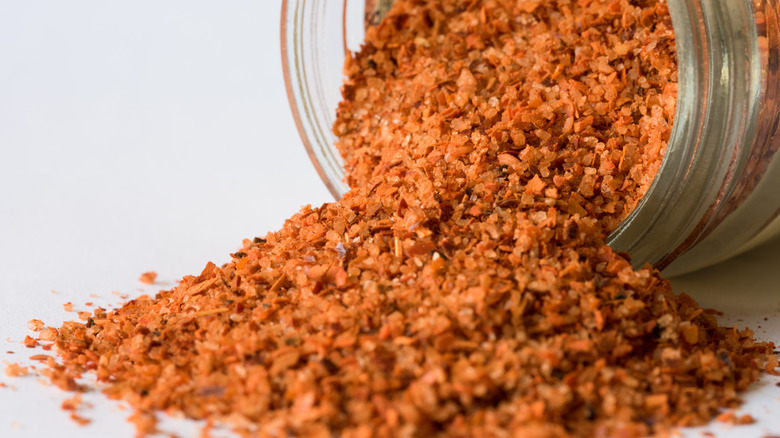How Tajín Went From Family Recipe To Global Spice Staple
You already know how good Tajín seasoning is if you've tried mango slices sprinkled to salty-sweet perfection with the spicy red seasoning. Tajín and mango is a pairing as natural as peanut butter and jelly, and, according to Allrecipes, the combo can be seen in everything from jello shots to ice pops. If drinks sound more refreshing, try layering cold, blended mango with Tajín and chamoy (another flavorful Mexican condiment) to make mangonadas (via The New York Times).
But uses for Tajín go well beyond adding it to mangoes. According to My Recipes, the seasoning makes the perfect topping for sliced raw vegetables like cucumbers and jicama, cutting the watery veggies with a pleasantly spicy kick. Tajín also brings a flavorful bite when used in meat, poultry, seafood marinades, and can even be the perfect finishing touch for corn — on the stick, as with Mexican elotes, or off it, in the creamy corn salad dish known as esquites (via The Pioneer Woman).
Although it packs a powerful flavor, Tajín seasoning is relatively simple. According to The Spruce Eats, it's a blend of ground red chilies, dried lime juice, sea salt, and a compound to prevent the particles from caking together. A mix of spicy, citrusy, and salty flavors, you don't need much Tajín seasoning on your food to reap the benefits. Let's look at where this iconic blend came from and how it became as popular as it is today.
A grandmother's sauce turned worldwide seasoning success
According to Thrillist, Tajín creator Horacio Fernandez loved smothering corn with his grandmother's chile sauce, so he set out to make a seasoning based on the condiment. On December 23, 1985, Tajín was born. Fernandez visited an archeological site in Mexico, El Tajín, where he came up with the name for his seasoning based on the Uzo-Aztecan word for chili, "aji" (via Mental Floss).
Once Fernandez founded the Tajín company, he sold his blend bottle by bottle, and eventually, his product became a staple in Mexican cuisine (via Tajín). In 1993, Tajín made the leap to the U.S. and continued to find success there, so the company further expanded to other continents in the 2000s, according to Well and Good. In 2018, Tajín sold over 22 million pounds of their items in over 35 countries, so it's safe to say that Fernandez's family recipe is now a worldwide success (via The New York Times).
Not only is Tajín seasoning a business success, but it's become a staple in American cuisine as an authentic Mexican seasoning. It's low calorie (a quarter teaspoon has two calories) and has mild spiciness despite its chilies, according to Spiceography. And although Tajín has achieved global recognition, its roots can't be mistaken, as they're right on the Mexican flag-colored bottles.

